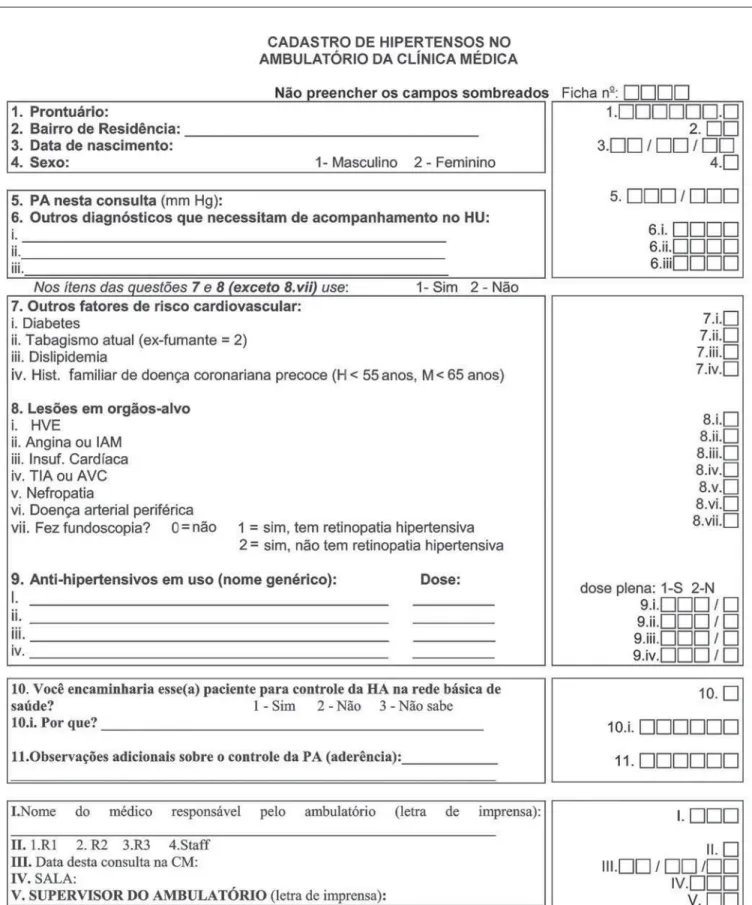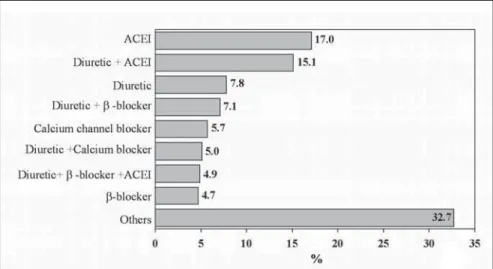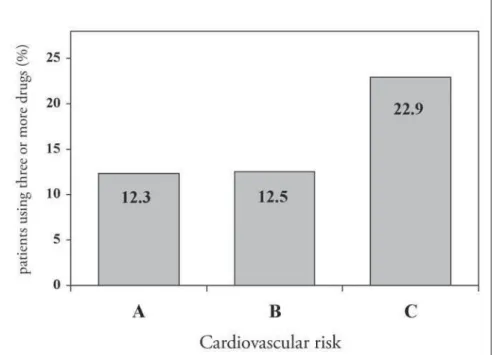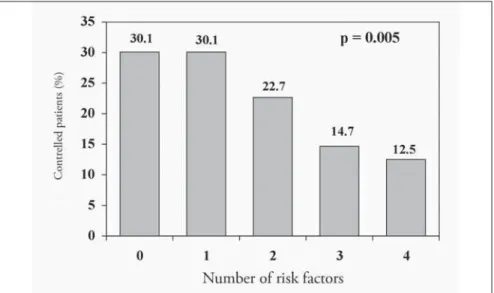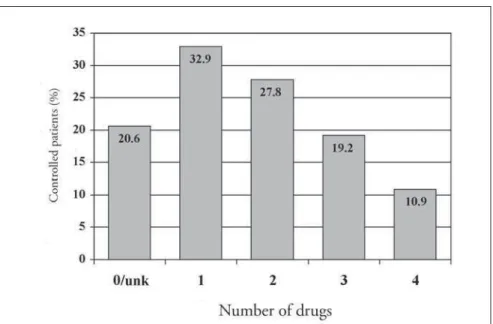○ ○ ○ ○ ○ ○ ○ ○ ○ ○ ○ ○ ○ ○ ○ ○ ○ ○
ABSTRACT
Original Ar
○ ○ ○ ○ ○ ○ ○ ○ ○ ○ ○ ○ ○ ○ ○ ○ ○ ○ ○ ○ Introduction
Cardiovascular diseases remain the lead-ing cause of death in Brazil, reachlead-ing 32.3% of all causes of mortality.1,2,3Arterial hyper-tension is the most frequent treatable cardio-vascular risk factor for death,2,3,4 with preva-lence ranging from 10 to 44% in different studies and countries.4-10
Without symptoms in its initial stage, hypertension is generally diagnosed only when complications appear, thus causing significant losses in quality of life and increasing mortal-ity rates. The costs for society are high, be-cause this condition requires tertiary care and affects an economically active part of the popu-lation.
Seeking to provide the necessary informa-tion for the planning of the arterial hyperten-sion program that was to be implemented in the Hospital Universitário Clementino Fraga Filho, Universidade Federal do Rio de Janeiro (HUCFF-UFRJ), hypertensive patients under treatment for at least three months in the in-ternal medicine outpatient unit were evaluated. Data on cardiovascular risk profile (risk factors and target organ damage), blood pressure con-trol, antihypertensive drugs prescribed and compliance with treatment were obtained by means of a standard questionnaire.
○ ○ ○ ○ ○ ○ ○ ○ ○ ○ ○ ○ ○ ○ ○ ○ ○ ○ ○ ○ OBJECTIVE
The objective of the study was to charac-terize the profile of hypertensive patients at-tended in the internal medicine outpatient unit of the Hospital Universitário Clementino Fraga Filho, Universidade Federal do Rio de
Janeiro (HUCFF-UFRJ), in order to imple-ment an arterial hypertension program at the hospital based on:
1) The demand for the treatment of hy-pertensive outpatients in a University Hospital.
2) The cardiovascular risk profile of these patients.
3) The flaws in the care provided for se-verely hypertensive patients, in order to improve its quality through the adoption of guidelines.
○ ○ ○ ○ ○ ○ ○ ○ ○ ○ ○ ○ ○ ○ ○ ○ ○ ○ ○ ○ Material and methods
Type of study
This was a descriptive cross-sectional study based on a census of the hypertensive patients, during the period from September 1998 to January 1999.
Setting
The study was conducted in the internal medicine outpatient clinic of the Hospital Universitário Clementino Fraga Filho, Universidade Federal do Rio de Janeiro, un-der the coordination of the Internal Medicine and Epidemiology Units.
Sample and Procedures
Data collection forms (Figure 1) were distributed to the 51 residents and 7 senior physicians of the Internal Medicine Unit, who had been previously trained to utilize the questionnaire and measure blood pres-sure in accordance with the Fourth Brazilian Guidelines on High Blood Pressure.11The mercury column sphygmomanometer was
patients in the internal medicine
outpatient clinic of a university
hospital in Rio de Janeiro
Hospital Universitário Clementino Fraga Filho, Universidade Federal do
Rio de Janeiro, Rio de Janeiro, Brazil
CONTEXT: Hypertension is one of the most important cardiovascular risk factors but its control is still a challenge for physicians all around the world. For blood pressure control to be improved, it is impor-tant to guarantee the quality of attendance provided for hypertensive patients, especially in teaching hos-pitals, where future physicians are being trained.
OBJECTIVE:To characterize the profile of hyperten-sive patients attending the internal medicine out-patient clinic of a university hospital in Rio de Ja-neiro, describing their cardiovascular risk and identifying flaws in the treatment provided for se-verely hypertensive patients, in order to implement an arterial hypertension management program.
TYPE OF STUDY: A descriptive cross-sectional popu-lation-based study.
SETTING: Hospital Universitário Clementino Fraga Filho, Universidade Federal do Rio de Janeiro.
METHODS:The study was carried out over a period of four months, involving all the hypertensive pa-tients under treatment in the outpatient unit. The attending physician obtained information relating to demographic features, cardiovascular risk fac-tors, target organ damage, blood pressure levels, therapeutic regimens and compliance with treat-ment. Means and the respective standard devia-tions and propordevia-tions were used to describe the distribution of patient data.
RESULTS: Of the total number of patients seen, 24.2% (1,699 patients) were hypertensive. Women ac-counted for 65.0% of the patients. The mean age was 63.9 years. Dyslipidemia (49.2%) and diabe-tes (29.8%) were the most frequently reported risk factors and heart disease was the most prevalent end-organ damage. Seventy percent of the patients were classified as high cardiovascular risk. In spite of the high intensity treatment provided for the most severe patients (19.4% on a regimen of 3 or more antihypertensive drugs), the rate of blood pressure control was low (27%).
CONCLUSIONS:The patients with arterial hyperten-sion under treatment at the university hospital had a profile of high cardiovascular risk and poor blood pressure control. Greater effort for improv-ing hypertension control is needed, since this is the only way to reduce the morbidity and mortal-ity rates of cardiovascular diseases.
urement was registered.
All the hypertensive patients11,12 who had been under treatment for at least 3 months were eligible to enter the study. Demographic fea-tures (gender, date of birth, place of residence), cardiovascular risk factors and the presence of target organ damage11,12 were registered. Dia-betes, dyslipidemia, family history of early coro-nary heart disease (men younger than 55 years of age and women younger than 65 years) and current smoking were appraised as risk factors. Target organ damage, such as left ventricular hypertrophy (electrocardiographic and/or echocardiographic criteria), coronary heart dis-ease (angina and/or myocardial infarction), heart failure (clinical and/or echocardiographic criteria), cerebrovascular diseases (stroke and/ or history of transient ischemic attacks), hy-pertensive retinopathy, nephropathy and pe-ripheral arterial disease were evaluated.
Diagnoses of risk factors (diabetes or dyslipidemia) and target organ damage could be based on clinical criteria or confirmed by complementary methods according to the attending physician, following criteria in the literature. The classification of cardiovascular risk was based on the Fourth Brazilian Guidelines on High Blood Pressure,11 as follows: risk A – patients without risk factors or target organ damage; risk B – patients with at least one risk factor, except diabetes, and without target organ damage; risk C – patients with diabetes or target organ damage, regardless of the presence of other risk factors.
The rate of hypertension control was de-fined as the number of treated hypertensive individuals with blood pressure less than 140/ 90 mmHg, divided by the total number of hypertensive individuals.9,11,12
Therapeutic regimens were also registered, as well as any intention to change them, on the part of the physician. The attending phy-sicians also gave their opinions regarding pa-tient compliance with the treatment.
The University Hospital Ethics Com-mittee had previously approved this study protocol.
Statistical analysis
Means and the respective standard viations and proportions were used to de-scribe the distribution of the data. The chi-squared test was used to determine the sta-tistical significance of the differences between the proportions and the Student t test was used to compare means.
A total of 1,699 hypertensive patients were registered, corresponding to 24.2% of all the outpatients attended in the Internal Medicine unit (7,160 patients) during the four-month period.
Women accounted for 65% of the pa-tients, and the average age was 63.9 years (standard deviation = 11.6). Most of the pa-tients (52%) were older than 65 years of age. Almost half of the patients (47.3%) lived near to the Hospital, while 18.3% came from outside the city of Rio de Janeiro.
Cardiovascular risk factors
The most frequent risk factor was dysli-pidemia (44.2%), followed by diabetes mellitus (29.8%). A family history of coro-nary heart diseases was present in 18.5% of the patients and only 7.7% were smokers. It was observed that 30.7% of the patients did not present any cardiovascular risk fac-tor, while 37.3% had one risk factor and 27.2% presented two or more. We had no information about risk factors in only 4.8% of the patients.
Target organ damage
In 39.2% of the patients, no target organ involvement was diagnosed, while 29.4% had one damaged organ and 25.2% had two or more. Heart involvement was the most fre-quent finding (46.1%), followed by cerebrovascular disorders (30.8%), hyperten-sive nephropathy (11.1%) and peripheral ar-terial disease (8.4%).
Left ventricular hypertrophy was the most common heart damage (33.9%), followed by
registered in 22.3% of patients. However, in 52.1% of the patients, funduscopic examina-tion was not performed at all.
In the cardiovascular risk classification, 70% of the patients were included in cardio-vascular risk category C, 14.9% in category B and 15.1% in category A.
Antihypertensive therapeutics
Diuretics were the pharmacological group that was prescribed most (33.5%): mainly hydrochlorothiazide. Angiotensin-converting enzyme inhibitors were used in 31.2% of the patients, and captopril was the most frequently prescribed of these. Cal-cium channel blockers and beta-blockers were prescribed with the same frequency (14.5%), and nifedipine and propranolol were the drugs most used in each group. Figure 2 presents the most common thera-peutic regimens.
Monotherapy was prescribed for 36.3% of the patients, while 41.9% used two drugs and 19.4% used three or more antihyperten-sive drugs. Only 2.4% of the patients were solely on non-pharmacological treatment.
High cardiovascular risk and the presence of target organ damage, especially heart in-volvement, determined the intensity of treat-ment (number of antihypertensive drugs pre-scribed). However, the same was not observed with the diabetic hypertensive patients (Fig-ures 3 and 4).
The attending physicians considered that 55.1% of the patients were complying with regular use of the antihypertensive medications.
Figure 2. Most commonly used anti-hypertensive therapeutic regimens among patients seen in Hospital Universitário
Blood pressure control
Of the 1,699 hypertensive patients, 27% had their condition under control. The con-trol rate was similar in both genders (p = 0.29). However, the controlled patients were older than uncontrolled ones (68.2 compared with 62.3 years; p < 0.001). The attending physi-cians reported that they intended to change the
of three or more antihypertensive drugs with different mechanisms of action)13 was diagnosed in 257 patients (15.1%).
The majority of the blood pressure records (93.4%) made approximations of the values to multiples of 5 or 10.
○ ○ ○ ○ ○ ○ ○ ○ ○ ○ ○ ○ ○ ○ ○ ○ ○ ○ ○ ○ DISCUSSION
The evolution of epidemiological, clini-cal and technologiclini-cal knowledge has given the possibility of interventions at different levels of prevention and treatment, that are capable of reducing cardiovascular morbid-ity and mortalmorbid-ity.13-16
This study was a tool for estimating the prevalence and severity of hypertension in the outpatient clinic unit of Hospital Universitário Clementino Fraga Filho, Universidade Fed-eral do Rio de Janeiro, thereby allowing evalu-ation to be made of the quality and effective-ness of the health care provided. These results contributed towards planning the implemen-tation of a local hypertension program.
The observed prevalence of arterial hyper-tension was similar to what has been found in population-based studies in Brazil5-8 and other countries.4,9,10 High prevalence of dyslipidemia and diabetes14-16 was found, and heart involve-ment was the most common end-organ dam-age, especially left ventricular hypertrophy (33.9%)
Of the registered patients, 70% were clas-sified as being at high cardiovascular risk, a patient profile that requires tertiary care. These findings guided the objectives of the hyper-tension program.
The way in which the blood pressure was recorded in the present study reflects a reality of the health services. Despite the training given in blood pressure measurement, a strong tendency to approximate the values to multi-ples of 10 or 5 was observed, which compro-mised the correct evaluation of blood pres-sure control.
The therapeutic regimens most frequently prescribed (Figure 2) were appropriate, accord-ing to recent guidelines,11,12 and the highest intensity of treatment was found in patients with heart involvement and cardiovascular risk C (Figures 3 and 4). Nevertheless, only 27% of the hypertensive patients achieved blood pressure control, much lower than the desir-able rate. This is similar to findings from other studies done in Brazil6,8 and developed coun-tries,9,10 and it demonstrates the difficulty in achieving such a goal, which requires a search for new strategies and a change of approach to arterial hypertension.
Figure 3. Treatment intensity at the different levels of cardiovascular risk in patients seen in Hospital Universitário Clementino
Fraga Filho, Rio de Janeiro, Brazil.
Figure 4. Treatment intensity according to the presence of different target organs damaged and diabetes in patients seen in Hospital Universitário Clementino Fraga Filho, Rio de Janeiro, Brazil. MI = myocardial infarction. HF = heart failure. LVH =
left ventricular hypertrophy.
ure 5), probably because of the metabolic conditions associated. Otherwise, blood pres-sure control was independent of the number of target organs damaged (Figure 6) and it was similar at different levels of cardiovascu-lar risk: risk A (26.1%), risk B (27.8%) and risk C (27.8%) (Figure 7), although the in-tensity of treatment was higher among high-risk patients (Figure 3).
The attending physicians reported an in-tention to change therapeutic regimens in re-lation to only 20% of the uncontrolled pa-tients. The importance of a more rigorous control of blood pressure may be neglected when blood pressure levels are partially re-duced. The number of drugs was inversely related to blood pressure control, maybe be-cause greater numbers of drugs decreased the compliance with therapy (Figure 8). An even larger effort is necessary, to make sure that physicians understand the need for better con-trol over blood pressure, since this is the only way to achieve a significant reduction in the morbidity and mortality rates for cardiovas-cular diseases.
Optimized blood pressure control is es-sential for cardiovascular protection. The short-term priorities for achieving such a goal should be: enhancement of the accessibility of medical care, more rigorous adherence to the guidelines for diagnosis and treatment of high blood pressure, and stricter compliance with therapy.10
On the basis of such aims and the results from the present study, the hypertension pro-gram at the Hospital Universitário Clemen-tino Fraga Filho was implemented in 1999, with the following purposes:
1. To standardize the routine for the diag-nosis and treatment of hypertension in the hospital, thereby allowing for continuous evaluation and the construction of indi-cators to reflect the effectiveness and qual-ity of the attendance;
2. To improve cardiovascular risk stratifica-tion through the establishment of a spe-cific investigation routine, including fun-duscopy, ambulatory blood pressure monitoring and 24-hour microalbu-minuria evaluation.
3. To improve blood pressure control through a multidisciplinary approach to-wards patient follow-up, in order to in-crease compliance with antihypertensive treatment.
4. To offer training for undergraduate and postgraduate students in clinical and
epi-Figure 5. Blood pressure control rate according to the number of cardiovascular risk factors in patients seen in Hospital Universitário Clementino Fraga Filho, Rio de Janeiro, Brazil..
Figure 6. Blood pressure control rate according to the number of target organs damaged in patients seen in Hospital Universitário Clementino Fraga Filho, Rio de Janeiro, Brazil.
1. Ministério da Saúde. Fundação Nacional de Saúde. DATASUS (1998). Sistema de informação sobre mortalidade. 1979-1997: dados de declaração de óbito. Brasília.
2. Mansur AP, Favarato D, Souza MFM, et al. Tendência do risco
de morte por doenças circulatórias no Brasil de 1979 a 1996. [Trends in death from circulatory diseases in Brazil between 1979 and 1996]. Arq Bras Cardiol. 2001;76(6):497-510.
3. Souza MFM, Timerman A, Serrano Júnior CV, Santos RD,
Mansur AP. Trends in the risk of mortality due to cardiovascu-lar diseases in five Brazilian geographic regions from 1979 to 1996. Arq Bras Cardiol. 2001;77(6):562-75.
4. From the Centers for Disease Control and Prevention. Decline
in deaths from heart disease and stroke – United States, 1990-1999. JAMA. 1999;282(8):724-6.
5. Lessa I. Epidemiologia da hipertensão arterial sistêmica e da
insuficiência cardíaca no Brasil. [Epidemiology of arterial hy-pertension and heart failure in Brazil]. Rev Bras Hipertens. 2001;8(4):383-92.
6. Fuchs SC, Petter JG, Accordi MC, et al. Estabelecendo a
prevalência de hipertensão arterial sistêmica. Influência dos
○ ○ ○ ○ ○ ○ ○ ○ ○ ○ ○ ○ ○ ○ ○ ○ ○ ○ ○ ○ ○ ○ ○ ○ ○ ○ ○ ○ ○ ○ ○ ○ ○ ○ ○ ○ ○ ○ ○ ○ ○ ○ ○ ○ ○ ○ ○ ○ ○ ○ ○ ○ ○ ○ ○ ○ ○ ○ ○ ○ ○ ○ ○ ○ REFERENCES
Accessed in 2003 (Oct 29)
12. Chobanian AV, Bakris GL, Black HR, et al. The Seventh Re-port of the Joint National Committee on Prevention, Detec-tion, Evaluation and Treatment of High Blood Pressure: the JNC 7 report. JAMA. 2003;289(19):2560-72
13. McAlister FA, Lewanczuk RZ, Teo KK. Resistant hypertension: an overview. Can J Cardiol. 1996;12(9):822-8.
14. Barreto SM, Passos VMA, Firmo JOA, Guerra HL, Vidigal PG, Lima-Costa MFF. Hypertension and clustering of cardiovascular risk factors in a community in Southeast Brazil – The Bambuí Health and Ageing Study. Arq Bras Cardiol. 2001;77(6):576-81. 15. Piccini RX, Victora CG. Hipertensäo arterial sistêmica em área urbana no sul do Brasil: prevalência e fatores de risco. [Systemic arterial hypertension in an urban area of southern Brazil: prevalence and risk factors]. Rev Saude Publical. 1994;28(4):261-7.
16. Kannel WB. Cardioprotection and antihypertensive therapy: the key importance of addressing the associated coronary risk factors (the Framingham experience). Am J Cardiol. 1996; 77(6):6B-11B.
critérios de amostragem. [Establishing the prevalence of hyper-tension. Influence of sampling criteria] Arq Bras Cardiol. 2001;76(6):445-52.
7. Bloch KV, Klein CH, Souza e Silva NA, Nogueira AR, Campos
LHS. Hipertensão arterial e obesidade na Ilha do Governador – Rio de Janeiro. [Arterial hypertension and obesity in Ilha do Governador – Rio de Janeiro]. Arq Bras Cardiol. 1994;62(1):17-22.
8. Freitas OC, Carvalho FR, Neves JM, et al. Prevalência de
hipertensão arterial sistêmica na população urbana de Catanduva, SP. [Prevalence of hypertension in the urban popu-lation of Catanduva, in the State of São Paulo, Brazil]. Arq Bras Cardiol. 2001;77(1):9-21.
9. Wolf-Maier K, Cooper RS, Banegas JR, et al. Hypertension
prevalence and blood pressure levels in 6 European countries, Canada, and the United States. JAMA. 2003;289(18):2363-9. 10. Staessen JA, Kuznetsova T, Stolarz K. Hypertension prevalence and stroke mortality across populations. JAMA. 2003; 289(18):2420-2.
11. IV Diretrizes Brasileiras de Hipertensão Arterial. 2002. Avail-able from URL: http://publicacoes.cardiol.br/consenso/#2002.
The problems observed in the investiga-tion and treatment of hypertensive patients that led to these findings has resulted in the drafting of guidelines for the diagnosis, treat-ment and managetreat-ment of arterial hyperten-sion, which are now in their fourth edition. Also, a new care unit for patients with resist-ant hypertension was created to study better approaches for their follow-up and treatment. Research in this area is increasing and con-tributing towards better understanding of this complex health problem.
○ ○ ○ ○ ○ ○ ○ ○ ○ ○ ○ ○ ○ ○ ○ ○ ○ ○ ○ ○ CONCLUSIONS
This large descriptive cross-sectional study among outpatients attending a university ter-tiary-care hospital showed that hypertensive patients had a profile of high cardiovascular risk and low blood pressure control rate.
The hypertension program of Hospital Universitário Clementino Fraga Filho is mak-ing great efforts towards improvmak-ing the com-pliance of physicians and other health person-nel with the hypertension guidelines, in order to improve blood pressure control. This is the only way to achieve a significant reduction in the morbidity and mortality rates for cardio-vascular diseases.
demiological areas related to hypertension. 5. To create a special outpatient service for resistant hypertension, so as to improve follow-up and research new approaches towards decreasing cardiovascular mor-bidity and mortality. These include the
construction of an information system that allows the investigation of associations between clinical and demographic vari-ables and cardiovascular outcomes in this special group of resistant hypertensive patients.
Figure 8. Blood pressure control rate according to the treatment intensity in patients seen in Hospital Universitário Clementino
○ ○ ○ ○ ○ ○ ○ ○ ○ ○ ○ ○ ○ ○ ○ ○ ○ ○ ○ ○ PUBLISHING INFORMATION
Elizabeth Silaid Muxfeldt, MD in Cardiology. Inter-nal Medicine Unit, Hospital Universitário Clementino Fraga Filho, Universidade Federal do Rio de Janeiro, Rio de Ja-neiro, Brazil.
Armando da Rocha Nogueira, PhD in Internal Medi-cine. Epidemiology Unit, Hospital Universitário Clementino Fraga Filho, Universidade Federal do Rio de Janeiro, Rio de Janeiro, Brazil.
Gil Fernando Salles, PhD in Internal Medicine. De-partment of Internal Medicine, Medical School, Universidade Federal do Rio de Janeiro, Rio de Janeiro, Brazil.
Kátia Vergetti Bloch, PhD in Public Health. Depart-ment of Preventive Medicine, Medical School, Universidade Federal do Rio de Janeiro, Rio de Janeiro, Brazil.
Sources of funding: None
Conflict of interest: None
Date of first submission: June 17, 2003
Last of received: October 31, 2003
Accepted:November 13, 2003
Address for correspondence:
Elizabeth Silaid Muxfeldt
Rua Conde de Bonfim, 590/601 — Tijuca Rio de Janeiro/RJ — Brasil — CEP 20520-055 Tel. (+55 21) 2570-1374
Fax (+55 21) 3238-2393 E-mail: bethmux@email.iis.com.br
Características clínicas e demográficas dos paci-entes hipertensos acompanhados no ambu-latório de Clínica Médica de um hospital universitário na cidade do Rio de Janeiro
CONTEXTO: A hipertensão é um dos mais im-portantes fatores de risco cardiovasculares e a dificuldade de controle dos níveis tensionais é um desafio aos médicos em todo o mundo. Para melhorar o controle da pressão arterial é importante garantir a qualidade da assistên-cia aos pacientes hipertensos, principalmen-te em hospitais de ensino nos quais futuros médicos estão sendo formados.
OBJETIVOS: Caracterizar o perfil dos hipertensos do ambulatório de Clínica Mé-dica de um hospital universitário no Rio de Janeiro e descrever o risco cardiovascular des-ses pacientes, identificando as falhas na assis-tência prestada aos hipertensos graves, visan-do nortear a implementação de um Progra-ma de Hipertensão Arterial do hospital.
TIPO DE ESTUDO: Estudo descritivo transversal.
LOCAL: Ambulatórios de Clínica Médica do Hos-pital Universitário Clementino Fraga Filho da Universidade Federal do Rio de Janeiro.
MÉTODOS: A população alvo foi composta pe-los pacientes hipertensos em acompanhamento no ambulatório de Clínica Médica por um pe-ríodo de quatro meses. Os médicos assistentes obtiveram informações sobre dados demográficos, fatores de risco cardiovascular, lesões de órgãos-alvo, pressão arterial na con-sulta, terapêutica instituída e adesão do
paci-○ ○ ○ ○ ○ ○ ○ ○ ○ ○ ○ ○ ○ ○ ○ ○ ○ ○ ○ ○ ○ ○ ○ ○ ○ ○ ○ ○ ○ ○ ○ ○ ○ ○ ○ ○ ○ ○ ○ ○ ○ ○ RESUMO
ente ao tratamento. A distribuição das carac-terísticas dos pacientes foi descrita com as mé-dias e respectivos desvios-padrão e proporções.
RESULTADOS: Dentre os pacientes vistos no período, 24,2% (1.699 pacientes) eram hipertensos, dos quais 65% eram mulheres. A idade média foi de 63,9 anos (desvio-pa-drão = 11,6). Dislipidemia (49,2%) e diabe-tes (29,8%) foram os fatores de risco mais encontrados, o órgão alvo mais atingido foi o coração (46,1%) e 70% dos pacientes fo-ram estratificados como de alto risco cardiovascular. Apesar da elevada intensida-de intensida-de tratamento instituído nos pacientes mais graves (19,4% em um regime de trata-mento anti-hipertensivo com três ou mais drogas) o controle da pressão arterial foi bai-xo (27%). Este estudo orientou a elaboração de uma rotina de diagnóstico e tratamento de hipertensão arterial e norteou os objetivos do Programa de Hipertensão Arterial do Hospital Universitário Clementino Fraga Fi-lho, Universidade Federal do Rio de Janeiro (UCFF-UFRJ), recém-implantado.
CONCLUSÃO:Os pacientes hipertensos em tra-tamento neste Hospital têm elevado risco cardiovascular e controle inadequado dos ní-veis tensionais. Faz-se necessário maior esfor-ço para controlar a pressão arterial, pois só assim será possível reduzir a morbimortalidade cardiovascular.
